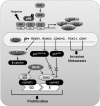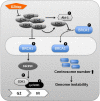EZH2 methyltransferase and H3K27 methylation in breast cancer
- PMID: 22211105
- PMCID: PMC3226033
- DOI: 10.7150/ijbs.8.59
EZH2 methyltransferase and H3K27 methylation in breast cancer
Abstract
Histone modifications are thought to control the regulation of genetic programs in normal physiology and cancer. Methylation (mono-, di-, and tri-methylation) on histone H3 lysine (K) 27 induces transcriptional repression, and thereby participates in controlling gene expression patterns. Enhancer of zeste (EZH) 2, a methyltransferase and component of the polycomb repressive complex 2 (PRC2), plays an essential role in the epigenetic maintenance of the H3K27me3 repressive chromatin mark. Abnormal EZH2 expression has been associated with various cancers including breast cancer. Here, we discuss the contribution of EZH2 and the PRC2 complex in controlling the H3K27 methylation status and subsequent consequences on genomic instability and the cell cycle in breast cancer cells. We also discuss distinct molecular mechanisms used by EZH2 to suppress BRCA1 functions.
Keywords: BRCA1; Breast cancer; EZH2; H3K27 methylation.
Conflict of interest statement
Conflict of Interests: The authors have declared that no conflict of interest exists.
Figures



Similar articles
-
A model for transmission of the H3K27me3 epigenetic mark.Nat Cell Biol. 2008 Nov;10(11):1291-300. doi: 10.1038/ncb1787. Epub 2008 Oct 19. Nat Cell Biol. 2008. PMID: 18931660
-
Phosphorylation of EZH2 by CDK1 and CDK2: a possible regulatory mechanism of transmission of the H3K27me3 epigenetic mark through cell divisions.Cell Cycle. 2011 Feb 15;10(4):579-83. doi: 10.4161/cc.10.4.14850. Epub 2011 Feb 15. Cell Cycle. 2011. PMID: 21278485 Free PMC article.
-
FOXC1, a target of polycomb, inhibits metastasis of breast cancer cells.Breast Cancer Res Treat. 2012 Jan;131(1):65-73. doi: 10.1007/s10549-011-1396-3. Epub 2011 Apr 5. Breast Cancer Res Treat. 2012. PMID: 21465172
-
Inner workings and regulatory inputs that control Polycomb repressive complex 2.Chromosoma. 2012 Jun;121(3):221-34. doi: 10.1007/s00412-012-0361-1. Epub 2012 Feb 19. Chromosoma. 2012. PMID: 22349693 Free PMC article. Review.
-
Noncanonical Functions of the Polycomb Group Protein EZH2 in Breast Cancer.Am J Pathol. 2021 May;191(5):774-783. doi: 10.1016/j.ajpath.2021.01.013. Epub 2021 Feb 6. Am J Pathol. 2021. PMID: 33556366 Free PMC article. Review.
Cited by
-
Endothelial derived miRNA-9 mediated cardiac fibrosis in diabetes and its regulation by ZFAS1.PLoS One. 2022 Oct 14;17(10):e0276076. doi: 10.1371/journal.pone.0276076. eCollection 2022. PLoS One. 2022. PMID: 36240130 Free PMC article.
-
Infiltrating mast cells enhance prostate cancer invasion via altering LncRNA-HOTAIR/PRC2-androgen receptor (AR)-MMP9 signals and increased stem/progenitor cell population.Oncotarget. 2015 Jun 10;6(16):14179-90. doi: 10.18632/oncotarget.3651. Oncotarget. 2015. PMID: 25895025 Free PMC article.
-
Long non-coding RNAs in the failing heart and vasculature.Noncoding RNA Res. 2018 Apr 14;3(3):118-130. doi: 10.1016/j.ncrna.2018.04.002. eCollection 2018 Sep. Noncoding RNA Res. 2018. PMID: 30175285 Free PMC article. Review.
-
Long non‑coding RNA CASC2 enhances berberine‑induced cytotoxicity in colorectal cancer cells by silencing BCL2.Mol Med Rep. 2019 Aug;20(2):995-1006. doi: 10.3892/mmr.2019.10326. Epub 2019 Jun 3. Mol Med Rep. 2019. PMID: 31173223 Free PMC article.
-
EZH2 Contributes To Cisplatin Resistance In Breast Cancer By Epigenetically Suppressing miR-381 Expression.Onco Targets Ther. 2019 Nov 13;12:9627-9637. doi: 10.2147/OTT.S214104. eCollection 2019. Onco Targets Ther. 2019. PMID: 32009798 Free PMC article.
References
-
- Aagaard-Tillery KM, Suter MA, Harris A. et al. Epigenetics and reproduction and the developmental origins of health and disease. Anim Reprod. 2010;7:103–16.
-
- Peters AH, Kubicek S, Mechtler K. et al. Partitioning and plasticity of repressive histone methylation states in mammalian chromatin. Mol Cell. 2003;12:1577–89. - PubMed
-
- Schwartz YB, Pirrotta V. Polycomb silencing mechanisms and the management of genomic programmes. Nature Rev Genet. 2007;8:9–22. - PubMed
-
- Cao R, Wang L, Wang H. et al. Role of histone H3 lysine 27 methylation in Polycomb-group silencing. Science. 2002;298:1039–43. - PubMed
Publication types
MeSH terms
Substances
Grants and funding
LinkOut - more resources
Full Text Sources
Other Literature Sources
Medical
Miscellaneous

